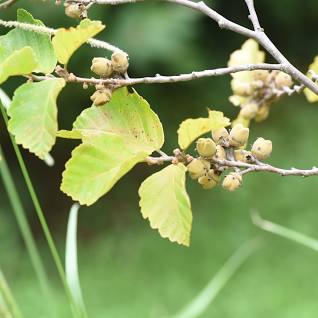
Close-up on Witch Hazel floral water
Share
Witch hazel is also known as witch hazel, witch hazel or devil's coffee.
It was already used by Native Americans to treat inflammation and haemorrhage. They then passed on their knowledge to today's local populations.
Witch hazel is a tree generally between 3 and 6 meters tall, but can sometimes reach 10 meters, with thin bark that is brown on the outside and reddish on the inside. Similar to the hazelnut tree, it has twisted, branched branches with downy, broad, oval, toothed leaves. The leaves are an attractive matte green. In autumn, they form sublime foliage in shades of yellow, green and orange. It also has yellow flowers and fruit. It belongs to the Hamamelidaceae family.

The name "witch hazel" comes from the Greek "Hama" (with, together) and "Melon" (fruit). This is a reference to the tree's ability to produce flowers and fruit simultaneously. The parts used are the leaves and bark. You can find it in America (United States and canada) and Europe.

Witch hazel can be consumed in a number of forms: essential oils, infusions or herbal teas, decoctions (boiling witch hazel in water for ten minutes), capsules and tablets, and mother tinctures.Witch hazel is widely used in cosmetics, notably in the form of floral water. Floral water, or hydrolat, is the aqueous phase following the production of an essential oil.
The Toning Floral Water, a star product at LISA NOTO natural cosmetics, is made from alcohol-free witch hazel distillates (or witch hazel extracts) are clear, colorless botanical extracts prepared from the recently cut and partially dried dormant twigs of the Hamamelis virginiana Linn plant. Our witch hazel is certified vegan, kosher and Ecocert/Cosmos.
The plant is suitable for oily and combination skin, as it helps to tighten pores and reduce imperfections. On the other hand, for sensitive and dry skin, it will help reduce and calm irritation, as well as providing a moisturizing and soothing effect. Witch hazel is used in make-up removers, serums, lotions and facial care products to refine skin texture and combat acne (by reducing the production of blemishes), while providing hydration.
The important benefits of witch hazel in cosmetics are:
1- Helps relieve skin inflammation.
Witch hazel contains numerous compounds with powerful anti-inflammatory properties, including gallic acid and tannins.
As a result, witch hazel could have considerable benefits and be useful in the treatment of problems linked to skin inflammation, such as acne, eczema or psoriasis.
Studies show that topical application of witch hazel can effectively reduce inflammation and help soothe the skin.
2- Sensitive skin characterized by abnormal sensory symptoms is a very common condition.
Some research suggests that applying witch hazel to the sensitive area may be beneficial in relieving irritated or abnormally sensitive skin.
3 - Thanks to its powerful anti-inflammatory properties, witch hazel could be useful in the treatment of acne. It can be applied directly to the face after cleansing for maximum effectiveness.
It has an astringent effect that causes tissue contraction to help shrink pores, while soothing the skin and relieving inflammation.
It can also prevent acne-causing bacteria from infecting the skin. It is particularly useful for people with oily skin.

4- Applying witch hazel floral water to the scalp before washing hair can help treat scalp sensitivity and relieve symptoms such as itching and sensitivity.
In short, witch hazel floral water is a must-have in any beauty and well-being routine. As well as being a natural product with astringent and purifying properties, witch hazel hydrosol tightens pores, softens skin and helps regulate sebum.
We hope this inspires you to make Toning Floral Water part of your LISA NOTO beauty and wellness routine.
References:
Hughes-Formella BJ, Filbry A, Gassmueller J, Rippke F. Anti-inflammatory efficacy of topical preparations with 10% hamamelis distillate in a UV erythema test. Skin Pharmacol Appl Skin Physiol. 2002 Mar-Apr;15(2):125-32. doi: 10.1159/000049400. PMID: 11867970. https://pubmed.ncbi.nlm.nih.gov/11867970/
Chularojanamontri L, Tuchinda P, Kulthanan K, Pongparit K. Moisturizers for Acne: What are their Constituents? J Clin Aesthet Dermatol. 2014 May;7(5):36-44. PMID: 24847408; PMCID: PMC4025519. https://www.ncbi.nlm.nih.gov/pmc/articles/PMC4025519/

